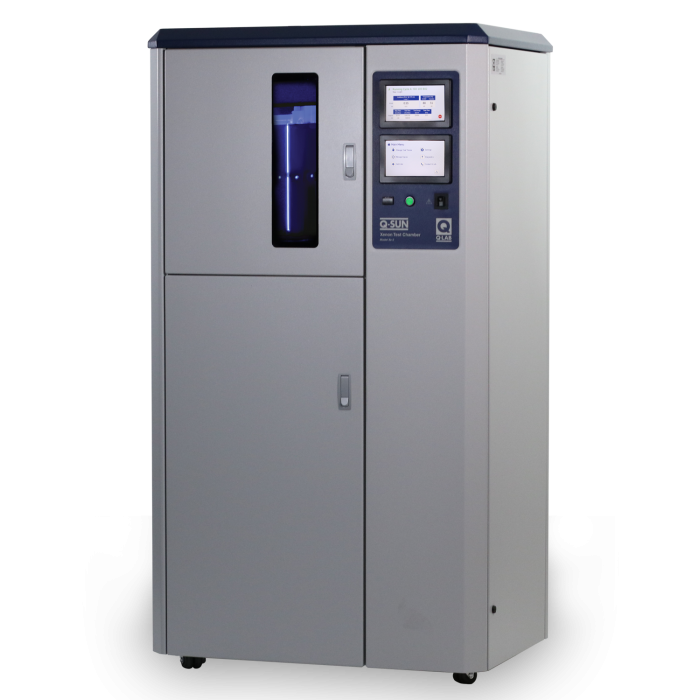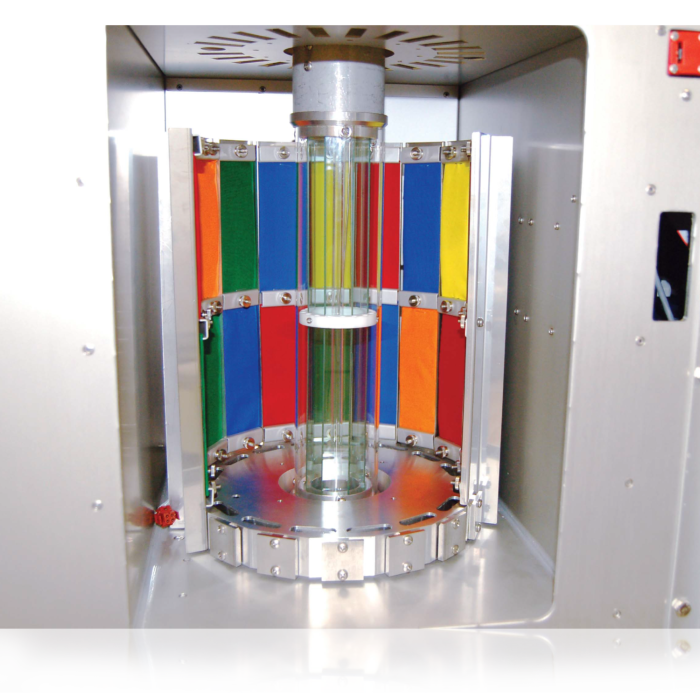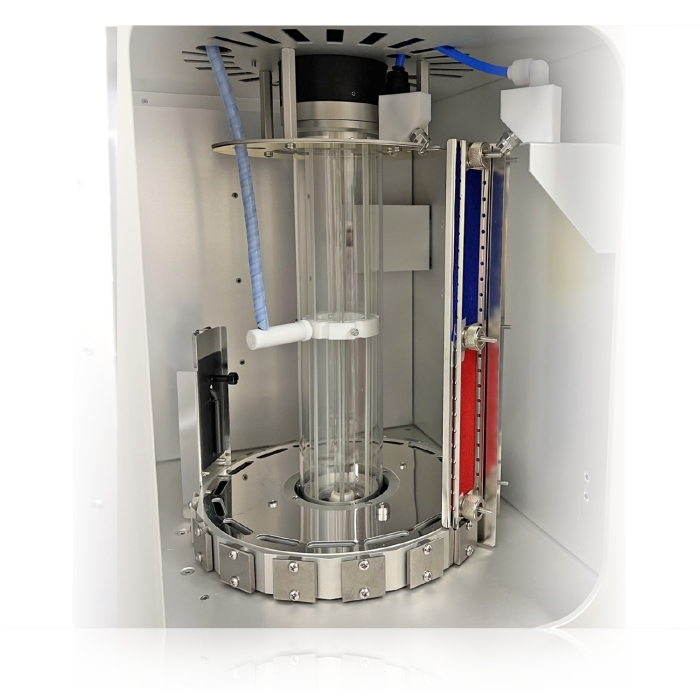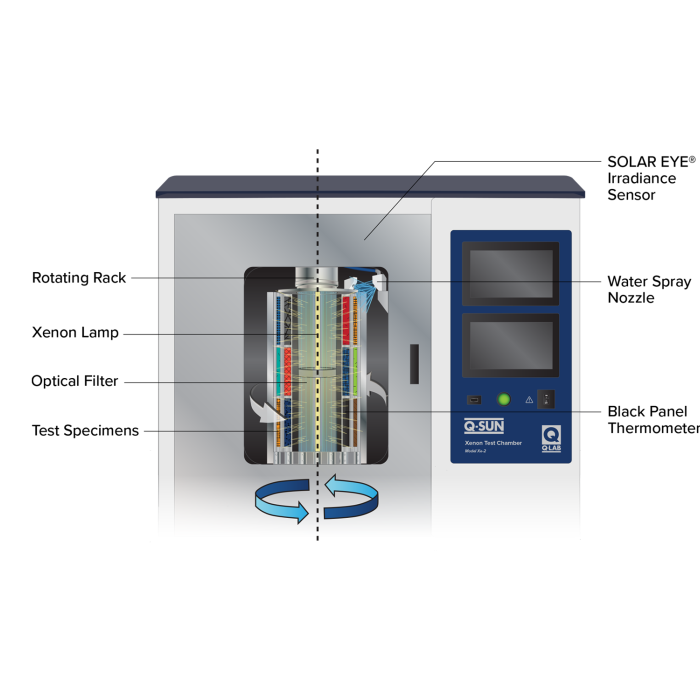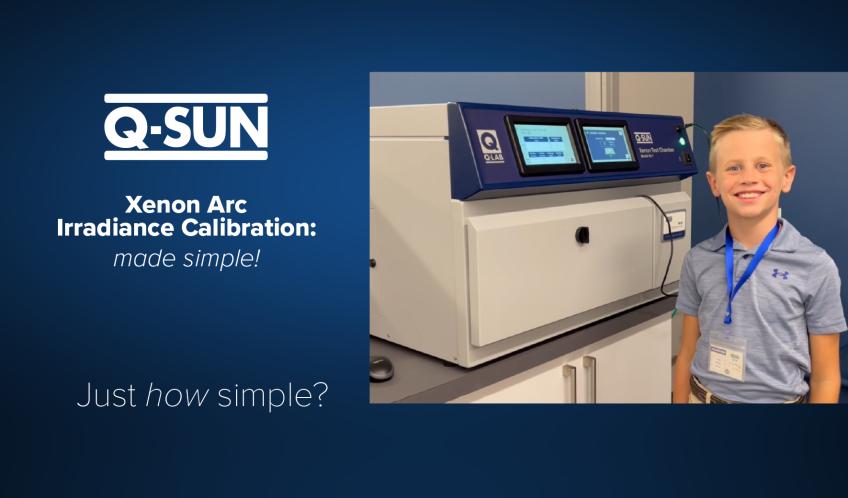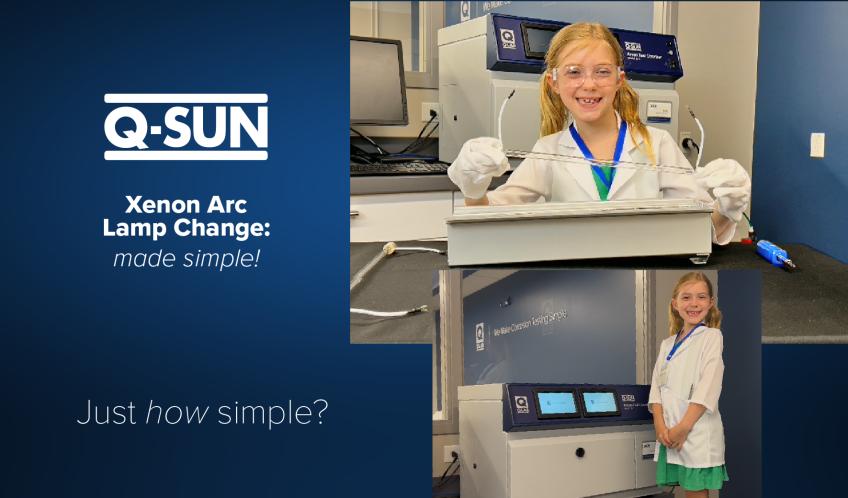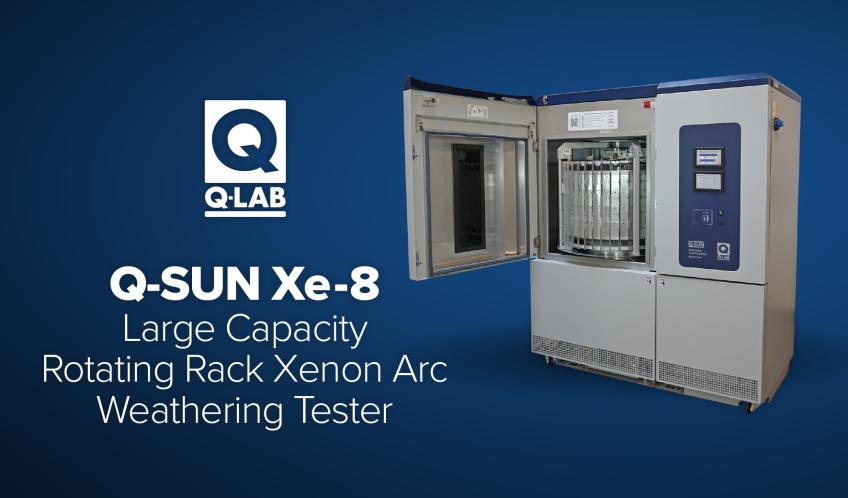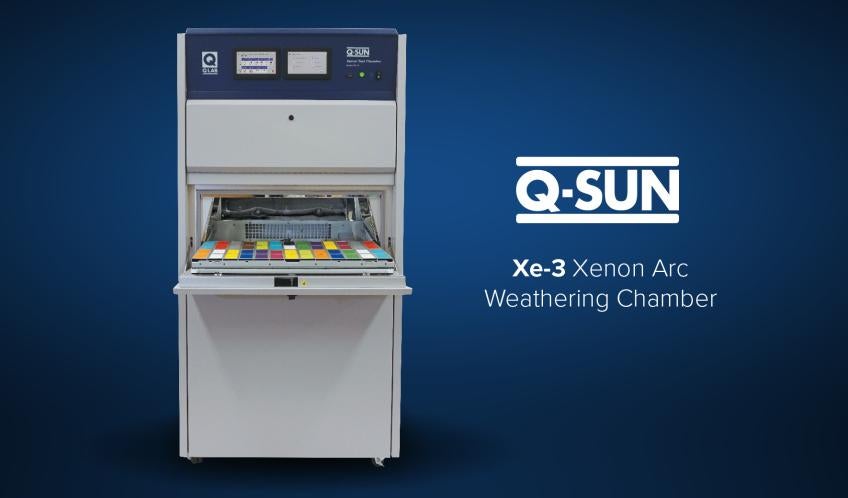Q-SUN® | Xe‑2
Xenon Arc Chamber | Rotating Rack
The Q-SUN Xe-2 rotating rack xenon arc test chamber reproduces the damage caused by full-spectrum sunlight, heat, and rain. In a few days or weeks, it can reproduce the damage that occurs over months or years outdoors.
The Q-SUN Xe-2 tester is a full-featured weathering, lightfastness, and photostability tester. It provides precise control of critical test parameters including light spectrum, irradiance, relative humidity, chamber temperature, and black panel/black standard temperature. Water spray is also an available option.
The versatile Q-SUN Xe-2 tester is the simplest, most reliable, and easiest-to-use rotating rack xenon arc tester available.
Realistic and Versatile
The Q-SUN Xe-2 rotating rack xenon arc chamber is a full-featured rotating rack weathering and lightfastness chamber. The Q-SUN Xe-2 tester’s xenon arc lamp provides the best match to full-spectrum sunlight. A variety of optical filters are available to match nearly any global xenon test standard. Simultaneous, precise control of relative humidity, chamber air, and black panel/black standard temperature is standard. Optional water spray can be added to simulate the erosion effects of rain.
Easy To Use
The Q-SUN Xe-2 xenon test chamber is easy to install, easy to use, and easy to maintain. Specimen mounting and evaluations are simplified with specially-designed specimen holders. The Q-SUN Xe-2 tester is completely automated and can operate continuously, 24 hours per day, 7 days per week. Other features include:
- Remarkably simple user interface in 17 user-selectable languages: English, Spanish, French, German, Italian, Japanese, Chinese, Korean, Czech, Dutch, Polish, Portuguese, Russian, Swedish, Thai, Turkish, and Vietnamese
- Built-in Ethernet connection for data logging
- Comprehensive self-diagnostic warnings and service reminders
- Quick and easy calibration with patented AUTOCAL system
Fast Results
A product exposed outdoors to direct sunlight experiences maximum light intensity for only a few hours each day. The Q‑SUN Xe‑2 tester can subject test specimens to the equivalent of noon summer sunlight for 24 hours a day, every day. This can highly accelerate the rate of product degradation and shorten test times.
Affordable
The Q‑SUN Xe‑2 tester’s low purchase price, low lamp prices, and low operating costs create an attractive price-to-performance ratio.
Configurations
- Q-SUN Xe-2-HE: full-spectrum sunlight, rotating rack specimen holder, humidity control, dual touchscreen displays
- Q-SUN Xe-2-HSE: full-spectrum sunlight, rotating rack specimen holder, humidity control and water spray, dual touchscreen displays
- Q-SUN Xe-2-HBSE: full-spectrum sunlight, rotating rack specimen holder, humidity control and water spray (front and back), dual touchscreen displays
See the Q-SUN Specification Bulletin or the Features Tab for comparative information.
Key Documents
Looking for additional information on the Q-SUN Xe-1? Browse our extensive document library for technical articles, technical bulletins, and more. Click here to view translated documents.
Full-Spectrum Xenon Lamps
Xenon arc lamps provide the best reproduction of full-spectrum natural sunlight. Q-Lab's lamps are air-cooled (not water-cooled), which makes them more economical, highly efficient, and very low-maintenance. Xenon lamps last for 3000 hours at normal irradiance and 1000 hours at high irradiance. The Q-SUN Xe-2 uses one lamp per machine. Visit our xenon arc lamps page for more information.
Optical Filters
The Q-SUN Xe-2 model’s optical filter lanterns are designed to produce the spectra specified in many global weathering and lightfastness test standards. These standards apply to a variety of industries for outdoor applications, as well as interior applications where sunlight may enter through a window. The lanterns consist of an outer borosilicate or quartz glass cylinder and two sets of 7 inner filters, arranged in a two-tier heptagon. The performance of Q-Lab's filters does not decline with age; therefore, filters do not need to be replaced under normal operation. The only exception to this is the Window-IR filter, which requires regular replacement. All Q-SUN Xe-2 models use one optical filter lantern per machine. See A Choice of Filters for Q-SUN.
Temperature Monitoring & Control
Control of temperature is important because it influences the rate of degradation. Specimen exposure temperature is precisely controlled in the Q-SUN Xe-2 tester using black panel and chamber air temperature sensors. The temperature can be set at any point between 35 °C and 105 °C, depending upon whether the black panel sensor is insulated or uninsulated, as well as irradiance level, filter type, lamp age and ambient room temperature. See the Q-SUN Specification Bulletin for more information.
High Specimen Capacity
The Q-SUN Xe-2 tester has a large specimen capacity, supporting 31 specimens of 45 × 132 mm (1.8 × 5.2 in) each. Its vertically-mounted specimen holders are very easy to install and remove. See our Specimen Mounting Bulletin or Accessories tab for more information
SOLAR EYE Irradiance Control
The SOLAR EYE irradiance control system constantly monitors and controls lamp output. This assures precise light exposure and maximizes reproducibility of test results. Irradiance control is available at 340 nm, 420 nm, or TUV (Total UV, 300-400 nm). See the Q-SUN Brochure for more information.
Humidity Control
Relative humidity (RH) control is standard in the Q-SUN Xe-2 tester. It allows the user to simultaneously control and display RH, black panel temperature, and chamber air temperature. Note that purified water is required for proper operation of the RH system in the Xe-2 tester. See Q-SUN Specification Bulletin for details.
Optional Water Spray (Xe-2-HSE and Xe-2-HSBE)
Outdoor moisture attack is simulated via optional pure water spray in the Xe-2 tester. A spray nozzle located in the top of the chamber can be programmed to operate during either the dark or light cycle. Note that purified water is required for proper operation of the Xe-2 with water spray. SSee The Importance of Water Purification for more information.
Optional Back Spray (Xe-2-HBSE)
Back spray is available for the Xe-2 tester and is required by some SAE test methods; it allows water to be sprayed on both the front and back of specimens simultaneously. Note that purified water is required for proper operation of the Xe-2 with back spray. See The Importance of Water Purification for more information.
Software & Operations
The Q-SUN Xe-2 tester’s displays are designed to be both functional and easy-to-use. Q-SUN testers feature dual, full-color touchscreen displays and can be programmed in 17 user-selectable languages (English, French, Spanish, Italian, German, Chinese, Korean, Japanese, Czech, Dutch, Polish, Portuguese, Russian, Swedish, Thai, Turkish, and Vietnamese). This system includes complete self-diagnostic error checking, constantly monitoring the status and performance of all systems. It also displays tester error messages and routine service reminders as needed. The multicolor LED status indicator light updates users on the tester’s operational state at a glance.
An external USB port on every Q-SUN Xe-2 tester allows users to perform software upgrades quickly to address key performance issues. For quality systems that require documented proof of test conditions, this USB port can also be used to download tester performance history with Q-Lab's VIRTUAL STRIPCHART application. Data from the USB export can be emailed directly to Q-Lab's technical support desk for expert troubleshooting and diagnostics.
Xenon Arc Lamps for Full-Spectrum Light
The Q-SUN Xe-2 tester’s xenon arc lamps deliver the most realistic reproduction of full-spectrum sunlight, including ultraviolet, visible light, and infrared radiation. For many materials, exposure to the full spectrum is necessary to provide an accurate simulation, especially when testing for color change and lightfastness. See Q-SUN Brochure for details.
The Q-SUN Xe-2 tester uses a single, air-cooled xenon arc lamp. This significantly reduces operating and maintenance expenses compared to water-cooled lamps. Warrantied lamp life for Q-Lab’s “plus” lamps is 3000 hours at typical irradiance, and 1000 hours at high irradiance. Visit our xenon arc lamps page for more information.
Changing the Xe-2 lamp is quick and easy it is easily accessible from the top of the tester. Replacement only requires the user to open an access door, release a set screw, and remove the trigger finger. The lamp and lamp housing can then be simply lifted out of the tester.
A Choice of Optical Filters to Simulate a Variety of Environments
Xenon light must be properly filtered to achieve the appropriate spectrum for each particular application. Differences in spectra may affect both the speed and the type of degradation. The three categories of filters shown below are available to simulate a variety of service environments. The application or test method dictates which filters should be used. The Q-SUN Xe-2 tester’s long-life filters are exceptionally durable and maintain the required spectrum indefinitely. After many years of use, Q-SUN filters typically do not show any signs of aging. See A Choice of Filters for Q-SUN for a more detailed discussion.
Daylight Filters
Daylight filters are used to simulate direct, noon summer sunlight. They provide the best correlation to natural exposures for most applications. Materials that are typically used outdoors, like roofing and exterior coatings, should be tested using Daylight filters. Three different types of Daylight filters are available for the Q-SUN Xe-2 tester: Daylight-F, Daylight-Q, and Daylight-B/B. The Daylight-Q and Daylight-F filters meet the specifications of Type I Daylight filters described in ASTM and ISO standards. Daylight-B/B filters are classified as Type II Daylight filters.
Window Glass Filters
Window glass filters produce spectra equivalent to sunlight passing through window glass. This also simulates other indoor lighting, such as a typical commercial or office environment. Window glass filters are used for indoor materials such as printing materials and textiles. Four different Window glass filters are available for the Q-SUN Xe-2 tester: Window-Q, Window-B/SL, Window-SF-5, and Window-IR.
Extended UV Filters
Extended UV Filters transmit excess UV, below the normal cut-on of natural sunlight. They are used to produce faster or more severe test results. Extended UV Filters are specified in some automotive test methods and are sometimes used for aerospace applications. The most common Q-SUN filter of this type is the Extended UV-Q/B.
Low Cost Replacement Lamps for Atlas Weather-Ometer® Testers
Q-Lab also offers water-cooled replacement lamps for use in Atlas Weather-Ometer® models Ci35, Ci35A, Ci65, Ci65A, Ci4000, Ci4400, and Ci5000.
These low-cost water-cooled replacement lamps are guaranteed to have a comparable spectral irradiance to original lamps supplied by Atlas. The lamps meet a wide range of ISO, ASTM, SAE, and AATCC requirements.
See our Water-Cooled Lamps and Optical Filters Product Summary or visit our xenon arc water-cooled products page for more information.
®Weather-Ometer is a registered trademark of Atlas Material Testing, LLC
Temperature Calibration
The Q-SUN Xe-2 onboard black panel temperature sensor needs to be calibrated periodically by the user. This assures accurate and consistent results.
Calibrating the Xe-2 black panel temperature sensor is simple using the Universal Calibrator system’s UC202 calibrated temperature sensor and takes only a few minutes. Note that UC202 thermometers come with either an uninsulated black panel (UC202/BP) or insulated black panel (UC202/IBP) sensor. This sensor must match the type of sensor actually used in the Xe-2 tester. The low-cost, combination relative humidity/chamber air temperature is designed to be replaced once a year by the user and cannot be recalibrated.
Irradiance Calibration
The Q-SUN Xe-2 onboard SOLAR EYE irradiance sensor needs to be calibrated periodically by the user to assure accurate and consistent results.
Calibrating the Xe-2 tester is simple using the Universal Calibrator system’s UC20 calibration radiometer, and takes only a few minutes. UC20 devices are available with either a 340 nm, 420 nm, or 300-400 nm TUV (Total UV) sensor and must match the type of sensor actually used in the Q-SUN tester.
ISO 17025 Accredited Recalibration
Calibration of both the UC202 thermometers and UC20 radiometers needs to be performed annually. Both types of devices were designed to be disposable and cost-efficient, and can either be replaced annually with a freshly-calibrated device or returned to Q-Lab once per year for an inexpensive recalibration. See our Recalibration Return Procedure.
Q-Lab's calibration labs in the United States, Germany, United Kingdom, and China are ISO 17025 accredited by the American Association of Laboratory Accreditation (A2LA) to perform calibrations of UC sensors. Calibrations are traceable to the United States' National Institute of Standards and Technology (NIST).
Specimen Mounting
The Q-SUN Xe-2 tester has a large specimen capacity, supporting 31 specimens of 46 × 132 mm (1.8 × 5.8 in) each. Its vertically-mounted specimen holders are very easy to install and remove.
For common textile tests, a variety of different ISO and AATCC textile masks and picture-frame holder kits are available.
Visit our Specimen Mounting Bulletin for more information.
Water Repurification System
To significantly reduce the cost of running the Q-SUN Xe-2 tester’s optional water spray system, Q-Lab offers a Water Repurification System that reuses the water that normally would go down the drain. This system can save over 1,000 liters of expensive, purified water per day in a test cycle that calls for several hours of water spray, and can pay for itself in a matter of months.
Unlike competing systems that simply recirculate dirty water, Q-Lab's repurification system repurifies water in addition to conserving it. Major components include a water reservoir, a pump, a flow adjustment valve, a repurification cartridge, and a Total Dissolved Solids (TDS) purity monitor.
More Q-SUN Resources At Your Fingertips
Document Library
Browse Q-Lab’s extensive library of weathering testing literature and technical content.
Education
Check out blogs, case studies, articles, and webinars to build your knowledge of weathering testing.
Standards
Review setup and performance information on key international and OEM test standards from ASTM, ISO, SAE, JIS, GB, and more.
